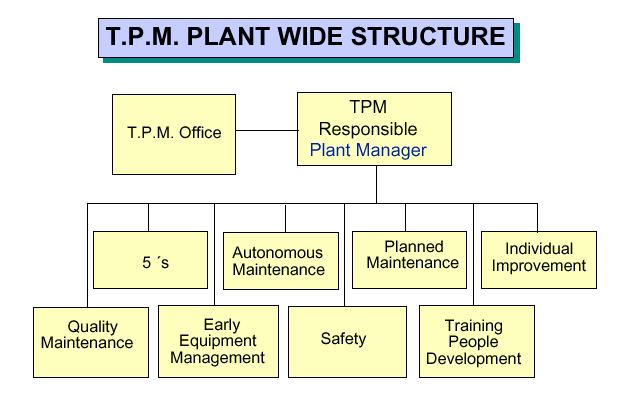What is Total Productive Maintenance ( TPM ) ?
Why TPM ?
- Produce a low batch quantity at the earliest possible time.
- Goods send to the customers must be non defective.
- Producing goods without reducing product quality.
- Reduce cost
- Avoid wastage in a quickly changing economic environment.
TPM Targets:
Obtain Minimum 80% OPE.
Obtain Minimum 90% OEE ( Overall Equipment Effectiveness )
Run the machines even during lunch. ( Lunch is for operators and not for machines ! )
Q
Operate in a manner, so that there are no customer complaints.
C
Reduce the manufacturing cost by 30%.
D
Achieve 100% success in delivering the goods as required by the customer.
S
Maintain a accident free environment.
M
Increase the suggestions by 3 times. Develop Multi-skilled and flexible workers.
| Motives of TPM |
|
| Uniqueness of TPM | The major difference between TPM and other concepts is that the operators are also made to involve in the maintenance process. The concept of "I ( Production operators ) Operate, You ( Maintenance department ) fix" is not followed. |
| TPM Objectives |
|
| Direct benefits of TPM |
|
| Indirect benefits of TPM |
|
Steps in introduction of TPM in a organization :
Step A - PREPARATORY STAGE :
STEP 1 - Announcement by Management to all about TPM introduction in the organization :
Proper understanding, commitment and active involvement of the top management in needed for this step. Senior management should have awareness programmes, after which announcement is made to all. Publish it in the house magazine and put it in the notice board. Send a letter to all concerned individuals if required.
STEP 2 - Initial education and propaganda for TPM :
Training is to be done based on the need. Some need intensive training and some just an awareness. Take people who matters to places where TPM already successfully implemented.
STEP 3 - Setting up TPM and departmental committees :
TPM includes improvement, autonomous maintenance, quality maintenance etc., as part of it. When committees are set up it should take care of all those needs.
STEP 4 - Establishing the TPM working system and target :
Now each area is benchmarked and fix up a target for achievement.
STEP 5 - A master plan for institutionalizing :
Next step is implementation leading to institutionalizing wherein TPM becomes an organizational culture. Achieving PM award is the proof of reaching a satisfactory level.
STEP B - INTRODUCTION STAGE
This is a ceremony and we should invite all. Suppliers as they should know that we want quality supply from them. Related companies and affiliated companies who can be our customers, sisters concerns etc. Some may learn from us and some can help us and customers will get the communication from us that we care for quality output.
STAGE C - IMPLEMENTATION
In this stage eight activities are carried which are called eight pillars in the development of TPM activity.
Of these four activities are for establishing the system for production efficiency, one for initial control system of new products and equipment, one for improving the efficiency of administration and are for control of safety, sanitation as working environment.
STAGE D - INSTITUTIONALISING STAGE
By all there activities one would has reached maturity stage. Now is the time for applying for PM award. Also think of challenging level to which you can take this movement
Organization Structure for TPM Implementation :

No comments:
Post a Comment